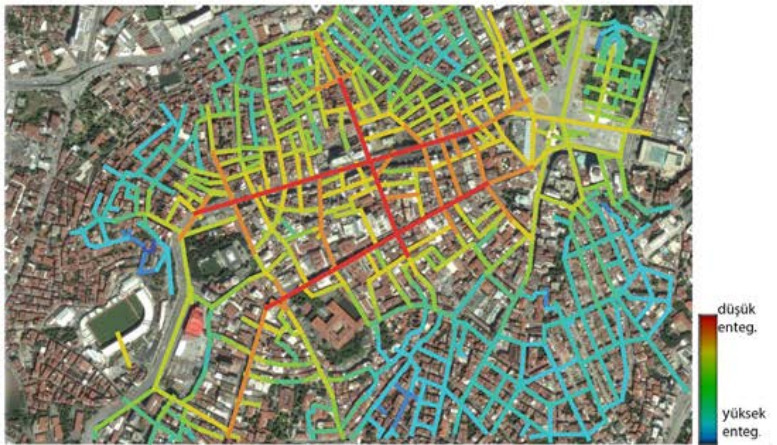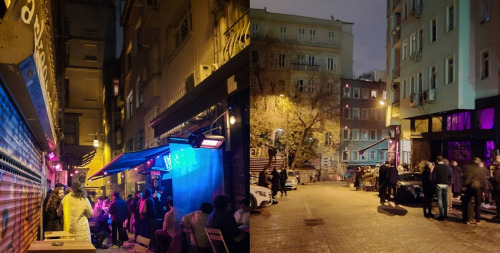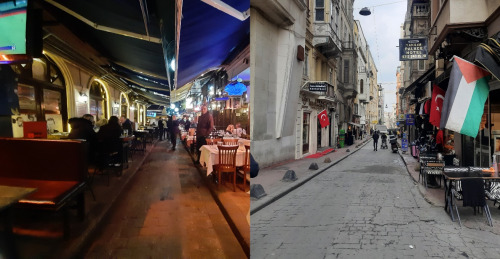
“We forfeit three-fourths of ourselves in order to be like other people. Arthur Schopenhauer”
I wandered around Beyoğlu last weekend, unhurriedly and mindfully; I also realized that this is the first time I’ve done this, frankly. During my walk, I observed some patterns that I’ve always looked at but could not previously see.
In fact, observing people is my hobby; I have long been aware of the fact that we have a nature prone to categorizing each other by virtue of the fact that the human being is judgmental and tribal. We feel the need to aggrandize and interact with those who think or are like us. On the other hand, we perceive others as factors that may create the potential for cultural conflicts. The irony is that we do this mostly involuntarily. Moreover, we do not easily give up defending or being surrounded by our “own” groups that we adopt, even if we do not benefit from them or, even, though we may suffer from this in-group interaction (https://www.foreignaffairs.com/articles/world/2018-06-14/tribal-world). This disintegration tendency, which we have gained throughout the evolutionary process (Yilmaz 2019), and which is largely involuntary, causes us to adopt people or groups that are similar to us, while making us prone to perceiving others as possible actors of cultural conflicts. It is known that even now, we do not have sufficient immunity to the ingrained nature of this behavior (Clark et al. 2019). While there is a moral aspect to this, it is also true that the polarizing nature of human beings is highly dependent on the functioning of our hormonal system (De Dreu et al. 2011). Since this behavior is complex, the combined use of social and biological methods to examine this complex structure is an approach that has recently been attracting attention (Cikara et al. 2014).
As mentioned above, our inclination and effort to interact with people and groups we feel close to is obvious and perhaps understandable in most cases, given our urge to avoid potential conflicts. Well, I question whether we can perceive the concrete or abstract reflections of this pattern in human-space interaction. Are there tangible implications of our need to be in places where we find ourselves culturally closer or where we feel more accepted? Do we really tend to concentrate more around these places? In most cases, I find this difficult to embody in a formulaic way. However, that places/spaces where we feel ourselves to be closer and safer, and even feel the need to belong, are more attractive to ourselves or to our group is an acceptable proposition.
It is known that people who share the same ethnicity or language tend to live together. Chinatowns in western countries, Kreuzberg in Berlin where many Turks live, and the neighborhood inhabited by a large Syrian community in the Fatih district of Istanbul (https://www.hurriyet.com.tr/gundem/istanbulda-kulturuyle-sanatiyla-ve -restaurant-syria-mahallesi-40026339) are the most concrete examples that come to my mind. Well, in popular non-residential areas, is there a tendency for groups of people on the move to gravitate towards places and areas that they feel socio-culturally close to or more embraced within? Let’s take a look at Beyoğlu, one of the busiest and most touristic areas of Istanbul… This region stands out for its social dynamics rather than its residential nature. In this context, contrary to the equalization and uniformity of residential areas (Saltman 1975), Beyoğlu is quite rich in terms of human-space interaction and diversity. To briefly touch on the principles of the “space syntax” theory: the movement and orientation of people is strongly related to the layout of the space through which they move (Hillier and Janson 1984). People move linearly and interact within convex spaces (Hiller and Vaughan 2007). In this context, when the morphological structure of Beyoğlu is considered, Tarlabaşı Boulevard is the scene of serious socio-cultural differences between its northern and southern ends. Istiklal Street, on the other hand, reflects a more capitalist individuality, and it is the main movement axis for pedestrians. The segregated side streets’ connection to Istiklal, on the other hand, are as transition lines (Figure 1) leading to places where people interact with each other or with the spatial cultures they feel close to (Özkan-Özbek 2021). It can be observed that people moving on Istiklal Street generally walk monotonously in a single line, meet their short-term needs in shopping and eating spots, and that many of them are on the move without even looking up. This dynamic of Istiklal started to gain momentum with the “Beautiful Beyoğlu Project” initiated in the early 1980s to improve the tourism potential of Beyoğlu (Keyder 1999). While there is a capitalist universality and relative monotony to Istiklal Street, the side streets and segregated spots lead people, who are similar to each other, to cluster.
Nodal points connecting the main axes and side streets force people to decide and make choices. Groups with similar cultural perceptions, interests, and backgrounds tend to concentrate in certain areas, since they have similar perceptual inferences (Lynch 1973). In this context, it can be observed that certain areas in Beyoğlu are concentrated with people who share similar cultural identities and lifestyles. For example, Akansu Street, Firuzağa (Figure 2), Hayriye Street, and Cihangir are preferred by the people that look more modern, are secular, enjoy popular culture, prefer alternative music movements, and consciously or unconsciously adopt escapism culture. This is so much so that the pro-Islamic municipality, which came to power with the 1994 local elections, wanted to equip public spaces with Islamic motifs, encouraging Islamic activities in public spaces, and this caused a polemic which escalated tensions between a secular mass in Cihangir and the municipality (Yetiskul and Demirel 2018). In addition, these regions and their groups attract attention as places preferred by young visitors, mainly from western countries.

Figure 2. On the left, Akansu Sokak, an isolated spot which has become popular for its entertainment venues and culture. On the right, a place from Firuzağa and people having fun (photos by author).
Unlike the cultural texture in the east and south of Istiklal Street, on the other hand, a different cultural texture prevails in the west. For example, the dominance of a traditional and arabesque culture is striking on Nevizade Street (Figure 3) and in its close vicinity. The domination of coffeehouse culture on the side streets of Şehit Muhtar Mahallesi (Figure 3), located just to the west of Taksim Square, is noticeable. Seeing “traditional” and “oriental” locals and Arab immigrants, who find themselves closer to the cultural texture in this area, is a common thing to observe. Again, in this area, the interest in Arabic and Kurdish songs can be easily perceived. The way people in this area look at people who are not like them draws attention. If you observe your environment carefully, you can see that many tourists and locals visit the streets here for a short period of time, mainly due to personal curiosity. Also, they often perceive this area as nothing but a transit route.

Figure 3. On the left, Nevizade Street; on the right, a street from Şehit Muhtar Mahallesi (photos by author).
Therefore, although there is a large range of factors that shape spatial and cultural segregation or concentration, it is clear that each spatial entity can be represented with a culture that has evolved over time. When looked at carefully, the reflections of this phenomenon can be seen in Beyoğlu. This inclination to cultural clustering, which can be sharper depending on the area, can often be perceived if you are careful enough.
But sometimes a cat can break the pattern 🙂

References
Cikara, Mina, and Jay J. Van Bavel. “The Neuroscience of Intergroup Relations: An Integrative Review.” Perspectives on Psychological Science: A Journal of the Association for Psychological Science 9, no. 3 (2014): 245–74. https://doi.org/10.1177/1745691614527464
Clark, Cory J, Brittany S. Liu, Bo M. Winegard, and Peter H. Ditto. “Tribalism Is Human Nature.” Current Directions in Psychological Science 28, no. 6 (2019): 587–92. https://doi.org/10.1177/0963721419862289
De Dreu, Carsten K. W., Lindred L. Greer, Gerben A. Van Kleef, Shaul Shalvi, and Michel J. J. Handgraaf. “Oxytocin Promotes Human Ethnocentrism.” Proceedings of the National Academy of Sciences of the United States of America 108, no. 4 (2011): 1262–66. https://doi.org/10.1073/pnas.1015316108
Hillier, Bill, and Julienne Hanson. The Social Logic of Space. Cambridge: Cambridge University Press, (1984). doi:10.1017/CBO9780511597237
Keyder, Çağlar. Istanbul: Between the Global and the Local. Lanham: Rowman and Littlefield, 1999.
Marcuse, Peter. “Enclaves Yes, Ghettos No, Segregation and The State.” In Desegregating The City, Ghettos, Enclaves & Inequality, edited by D. P. Varady, pp. 15–30. Albany: State University of New York Press, 2005.
Özkan-Özbek, Müge. “Tarihsel Süreçlerde Taksim Meydanı ve Beyoğlu Bölgesinin Morfolojik Evrimi ve Sentaktik Analizleri.” Tasarım Kuram 17, no. 32 (2021): 35–54.
Saltman, Juliet. 1975. “Implementing Open Housing Laws through Social Action.” Journal of Applied Behavioral Science 11: 39–61.
Vaughan, Laura. “The Spatial Syntax of Urban Segregation.” Progress in Planning 67 2007: 205–94.
Yetiskul, Emine, and Şule Demirel. “Assembling Gentrification in Istanbul: The Cihangir Neighbourhood of Beyoğlu.” Urban Studies 55, no. 15 (2018): 3336–52. https://doi.org/10.1177/0042098017746623
Yilmaz, Onurcan. “Prejudice as an Expression of Tribalism.” In Encyclopedia of Evolutionary Psychological Science, edited by T. Shackelford and V. Weekes-Shackelford, pp. 1-3, Springer, 2019. https://doi.org/10.1007/978-3-319-16999-6_3807-1

